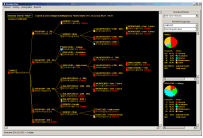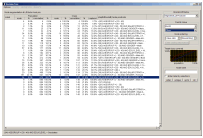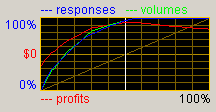|
|
|||
RFM Marketing and RFM ModelingIf real life intuition is any guidance, RFM marketing has its own legitimate place. RFM marketing is based on the following observations;
As our intuition tell us, these RFM variables can serve as predictive indicators for future customer responsiveness. In conventional RFM methods, customers are divided along with the RFM variables inducing segments. Some may result in highly positive customer responses. In scoring segments, there are non-statistical methods suggested. However, they that are not based on responsiveness of segments and therefore cannot be treated as a valid approach. Forget the voodoo methods! In the subsequent sections, three RFM methods based on statistical responsiveness of segments are described. These methods will maximize your RFM marketing result! How do you know that RFM works on your business well?A fundamentally important question! Much have been said about virtues of RFM segmentation marketing. There are a number of things to consider;
But still little has been proven objectively! The best method is to perform link analysis using correlation analysis and/or neural network. Correlation analysis can show degree of associations between RFM variables and response rates. Having high correlation coefficients means that the variables are good indicators for predicting responses. In addition, it can be used to analyze whether your variable-slot designs can lead to good segmentations. CMSR link analysis tools can be used to determine numerically whether a variable has correlations with responses. For more, read Link Analysis. RFM Analysis - Segment Response and Profit Analysis
RFM analysis is performed with gains charts. The gains chart shown above is an excellent tool for analyzing quality of your marketing plan. The blue curve indicates response capture ratios. That is, cumulative ratios of responsive customers out of all responsive customers. Rapidly rising curve is a good indication for efficient RFM marketing. It indicates that segments at the left-end have concentration of responsive customers! The white vertical line indicates a cut-off point. Focusing marketing on the left-side segments of the white line, you can improve response ratios and maximize net profit. The green curve shows quantity (or volume) capture ratios. Similarly, the red curve describes profit and loss amounts. RFM Segmentation marketingDecision tree classifier is a predictive model that is presented in a tree-like decision model. Decision Tree RFM Marketing is a RFM technique that uses Decision Tree Software in designing customer targeting. For more on RFM marketing and decision trees, please read RFM Marketing and Decision Tree Software CTM decision tree tools are well designed for RFM customer targeting. Subsequent sections describe how decision tree segmentation and analysis tools can be used for RFM customer targeting; Step 1: Data Preparation for RFM ModelingThe first step is to collect past historical data from which we can model customer behaviors, or customer purchasing patterns. Based on past campaign records, we can develop statistical models that can predict the likelihood of purchase of new campaign products. Using the models, we can select customers who are more likely to buy and conduct campaigns for the customers selected specifically. In this way, we can improve marketing efficiency and maximize profit. Select a campaign conducted in the past. Extract RFM information at the time of the past campaign. This is very important since if you use current information, RMF models will not have effective prediction. This means that you need to make backup copies before new campaigns. For each RFM variable, create a categorical interval variable. For example, RFM variables may be duplicated with the following categorizations;
In addition, response information of the past campaign is added to the data. If customers responded in the campaign, response is "Yes". Otherwise it is "No". Step 2: Develop Decision Tree RFM ModelsIn developing decision tree RFM segmentation models, six RFM variables and a response variable are used. Viz;
Use these variables as profiling fields and the response variable as the target variable for decision tree. If additional information is available, you may add them as well. For example, age, gender, etc. This may lead to better customer targeting models. 
Step 3: Targeting Segment SelectionThe next step is to perform lift factor and profit analysis. The tool shown in the following figure is used to arrange segments in the way that segments with higher profit or higher response rate appear earlier. 
Targeting segments are selected so as to maximize profit. Gains charts shown below (mid right in the above figure) automatically indicate which segments are targeted. The blue curve indicates cumulative response ratios. That is, cumulative ratios of responsive customers out of all responsive customers. Rapidly rising curve is a good indication for efficient RFM marketing. It indicates that segments at the left-end have concentration of responsive customers! The white vertical line in the middle indicates a cut-off point. Note that the white vertical line corresponds to the segment entry (in blue) selected in the above table. Customers belong to the segments at the right of the cut-off point are selected for catalog mailing. The rest in the right are ignored (reducing mailing costs roughly in half in this case). 
Step 4: Apply to Current Campaign DatabaseCustomers belonging to selected segments are mailed with catalogs. You may use CMSR data miner to mark customer database records. Or you can use your preferred tools to select current campaign records based on profiles of selected segments. For information about software used here, please read Data Mining Software. Software download is available from the page. For information about predictive modeling, please read Predictive Modeling Software Tools. |
|||
